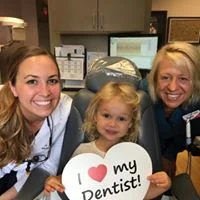Cleaning (Prophylaxis)
A professional dental cleaning, or prophylaxis, is purely a preventive measure to prevent tooth decay and gum disease by removing plaque and bacteria from your mouth.
Medical history and x-rays
Our hygienists begin your cleaning appointment by asking if there have been any changes to your medical history and taking your blood pressure, if you are 18 or older. If needed, they’ll take x-rays of your teeth to look for signs of tooth decay, hidden dental structures (such as wisdom teeth), and bone levels that cannot be assessed with the naked eye. At Grand Avenue Dental Care, we use digital x-rays because they emit up to 90 percent less radiation than a traditional machine, and they can be easily stored on computers, making the process safer and faster for our patients and staff.
Measuring gum pockets
Our hygienists measure the depth of the gum pocket, or sulcus, around each tooth. This is a good way to evaluate your periodontal, or gum and alveolar bone, health. Since the top of gum tissue does not attach directly to teeth, it creates a space, or pocket, between the gum and the tooth before it attaches. Gum disease, or Gingivitis, can cause this pocket to deepen. If left untreated, the deep pocket can harbor bacteria and eventually lead to Periodontitis, which is both gum and bone disease. Periodontitis is a chronic disease that can lead to an unhealthy mouth environment and early loss of teeth. Therefore, our hygienists measure, record and monitor the pocket depth around all of your teeth as part of their ongoing evaluation of your gum health.
Removing plaque and calculus
Next, our hygienists remove plaque and calculus from your teeth. Plaque is the sticky, soft film that contains millions of bacteria which develops on our teeth throughout the day. If not removed by daily brushing and flossing, plaque will cause both gum disease and tooth decay. Over time, plaque can develop into calculus, or tartar. Calculus is a hard, calcified deposit that forms on teeth and is a constant irritant to the gums. When removing plaque and calculus, we use both ultrasonic water scalers, which use water and high-frequency vibrations, as well as traditional metal scalers.
Polishing your teeth
After all of the plaque and calculus is removed from your teeth, our hygienists polish your teeth and finish with a professional floss. Your hygienist may recommend a fluoride varnish application to help strengthen your teeth. Children and adults alike can benefit from fluoride! The fluoride varnish we use is a very high concentration of fluoride that is very readily absorbed by your teeth. However, it is specially formulated to stick to your teeth so that very little, if any, is ingested.
Clinical exam
Finally, one of our dentists performs a clinical exam. The exam consists of reviewing x-rays and assessing teeth and soft tissues of the head and neck. Both parts of the exam complement each other and provide tons of information to determine if treatment is necessary.
The doctor will feel your Temporomandibular joint (jaw joint) as you open and close your mouth to ensure that your bite is smooth, aligned, and there is minimal clicking or popping. The doctor will palpate your neck to check for enlarged lymph nodes, which is part of the oral cancer screening. Other areas that are evaluated during the oral cancer screening are the back of the throat, sides of the tongue, and floor of the mouth. After the head and neck exam, the VELscope is used as another means to assess any abnormalities of the soft tissues of the mouth.
The doctor will then examine your teeth and gum tissue. They will check margins of crowns and other fillings, assess areas of gum recession and check for tooth decay. If any treatment is recommended, both the dentist and hygienist will be sure to explain the procedure to you. Both our dentists and hygienists can answer any questions or concerns you may have about the treatment, your understanding of your dental health is very important to us!
The American Dental Association (ADA) recommends visiting the dentist at regular intervals to maintain optimal oral health. Visiting your dentist regularly allows us to assess your daily brushing and flossing habits, as well as catch any tooth decay or periodontal disease early. Some patients who have high risk factors may need to have cleanings every three to four times a year, while low-risk patients may only need to have two cleanings per year. Many insurance plans cover two preventative dental visits per year and some offer additional visits if needed. We work with you to establish a personalized oral care plan that is best for you!

